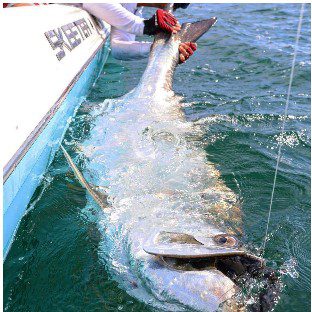The warm breezes and vibrant sunsets of St. Petersburg set the stage for an extraordinary adventure in pursuit of one of the most elusive giants of the sea: the tarpon. Captain Tyler Kapela, has a calm, patient and fun-loving demeanor who is also passionate, knowledgeable and a master of his craft.
In a recent dialogue, Joe Simonds, Co-Founder of Salt Strong Fishing Club, and Captain Tyler Kapela of Hit and Run Charters, in St. Petersburg, Florida, guide us through the thrilling world of tarpon fishing—a seasonal pursuit that captivates the hearts of anglers each year!
Captain Tyler’s journey with tarpon fishing begins with an understanding of the fish’s remarkable life cycle. Known for their epic migrations, tarpons start their life as tiny plankton hundreds of miles offshore, gradually making their way into coastal estuaries. These “silver kings” thrive even in low-oxygen environments, such as golf course ponds, and can breathe air, allowing them to inhabit waters few other fish can survive.
Migrating to open beaches and other main migration routes in May and June, the tarpon challenge intensifies. Captain Tyler Kapela shared several detailed strategies for targeting tarpon effectively:
Focus on Structure like bridges, which are ideal for finding early-season tarpon. Structures tend to hold baitfish, making them attractive spots for tarpon.
Use Technology like side imaging sonar, to locate tarpon, especially when they are not visibly rolling on the surface. This technology helps in identifying the tarpon’s position and movement beneath the water, which is crucial for effective bait placement.
Strategically Placing Bait to ensure it is the first thing the tarpon sees, without spooking the fish involves understanding the fish’s direction and behavior, particularly around structures like bridges and in open waters.
Captain Tyler Kapela is clearly committed to the conservation of tarpon and advocates for educating other anglers on best practices for tarpon fishing. He believes in sharing knowledge about sustainable fishing techniques, which can lead to better outcomes for the tarpon population and emphasizes several important practices aimed at protecting the health and survival of these magnificent, majestic fish after capture:
Handling Sharks: To protect tarpon from shark attacks once they are on the line, loosen the drag or move the tarpon quickly away from areas where sharks are active. This reduces stress on the tarpon and increases their chances of survival after release.
Proper Fight Management and Appropriate Use of Tackle: Captain Tyler emphasizes managing the duration of the fight appropriately so that the tarpon are not overly exhausted by using gear that is strong enough to handle tarpon efficiently and reducing the time it takes to bring them in. This lessens the physiological stress on the fish and helps maintain their strength, improving post-release survival. The use of appropriate tackle not only improves the angling experience but also enhances the survival rate of tarpon after release. Tyler chooses hooks and lines that minimize damage to tarpon, such as circle hooks that are more likely to hook the fish in the mouth, reducing internal injuries.
Proper Catch and Release Techniques are critical and he stresses the need to handle tarpon as little as possible, and when handling is necessary, to support the tarpon horizontally rather than hanging them vertically, which can damage their internal organs.
Captain Tyler Kapela is specific about the types of bait he prefers to use for targeting tarpon, and he tailors his bait selection based on the fishing environment and the behavior of the tarpon. Here’s a breakdown of the bait choices he discussed for different approaches:
Crabs and Threadfins Around Structures: When fishing around bridges and deeper structures, Tyler often uses crabs and threadfins. He finds these baits effective in attracting tarpon, which are drawn to these areas for the abundant food supply. During the peak migratory months of May and June, Tyler particularly highlights the effectiveness of using pass crabs. He notes that these crabs are naturally flushed out by the tides, and tarpon are accustomed to feeding on them. Catching and using pass crabs during this time can be highly effective, as it mimics the tarpon’s natural food source.
Live Baits in Open Waters: For beach fishing and targeting tarpon in open waters, Tyler prefers using live baits like pinfish, threadfins, and sometimes even smaller crabs. He emphasizes the importance of the bait being lively and well-presented, which makes it more attractive and triggers the predatory instincts of tarpon.
Tailored Bait Based on Tarpon Behavior: Tyler also discusses adjusting his bait choice based on the behavior of the tarpon on any given day. For example, if the fish are finicky or the water conditions are clear, he might choose smaller crabs or even artificial baits to match the hatch or to be less intrusive.
Tyler’s choices in bait reflect a deep understanding of the tarpon’s dietary preferences and how these preferences can be influenced by environmental conditions and the tarpon’s migratory patterns. By carefully selecting and presenting these baits, he maximizes his chances of successfully hooking these elusive giants during their most active seasons.
This article was created from Episode #304 – Tarpon Tactics with Captain Tyler Kapela http://www.youtube.com/@fishingstrong
The Salt Strong Fishing Club is an inspiration for in-shore saltwater anglers seeking not just to enhance their fishing success but also to foster a sense of unity and advocacy within the fishing community. Salt Strong Chapters are located from Texas to Florida to the Carolinas and offer Club Members the opportunity to Meet Local Anglers, Learn from Informative Speakers, Participate in Fun Tournaments, and Win Awesome Giveaways. Go to SaltStrong.com and Salt Strong Alliance.com to Learn More.

